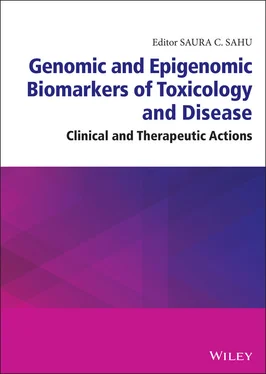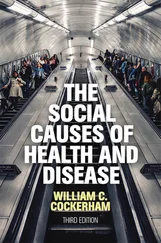Health, Pittsburgh, PA, USA
Wan-yee Tang
Department of Environmental and
Occupational Health, University of
Pittsburgh Graduate School of Public
Health, Pittsburgh, PA, USA
Erik J. Tokar
Mechanistic Toxicology Branch, Division
of the National Toxicology Program,
National Institute of Environmental Health
Sciences, NC, USA
Parayanthala Valappil Mohanan
Toxicology Division, Biomedical
Technology Wing, Sree Chitra Tirunal
Institute for Medical Sciences and
Technology, Poojappura, Trivandrum
Kerala, India
Libia Vega
Center for Research and Advanced Studies
of the National Polytechnic Institute,
Department of Toxicology, Ciudad de
México, México
Musa Watfa
Department of Environmental and
Occupational Health, University of
Pittsburgh Graduate School of Public
Health, Pittsburgh, PA, USA
Genki Yamagishi
Faculty of Advanced Engineering,
Tokyo University of Science,
Tokyo, Japan
Zhe Yang
Department of Biochemistry,
Microbiology, and Immunology,
Wayne State University School of
Medicine, Detroit, MI, USA
Yusuke Yoshioka
Division of Molecular and Cellular
Medicine, Institute of Medical Science,
Tokyo Medical University, Tokyo, Japan
Yingxue Zhang
Department of Biochemistry, Microbiology,
and Immunology, Wayne State University
School of Medicine, Detroit, MI, USA
1 Genomic and Epigenomic Biomarkers for Predictive Toxicity and Disease
Saura C. Sahu
Toxicity Testing in the Twenty-First Century
Consumer exposure to environmental chemicals is increasing. Therefore there is a need for developing short-term biomarkers for a rapid predictive toxicity screening of environmental chemicals. In 2007 the US National Academy of Sciences published its landmark report “Toxicity Testing in the 21st Century: A Vision and a Strategy” in order to reduce the costly and time-consuming classical animal studies required for safety risk analysis (Judson, Houck et al. 2016; Judson, Kavlock et al. 2013; Krewski et al. 2010; NAS 2007). In vitro cytotoxicity assays using human primary cells and cell lines in culture with focus on biological pathways is an important part of the twenty-first-century toxicity screening program. Alternative in vitro screening assays of this kind reduce, refine, and replace animal testing. One of the important goals of the twenty-first-century toxicity testing is the development of in vitro assays designed to predict the in vivo outcomes. In consequence, such asays can be used to predict starting doses for animal studies (Judson, Houck et al. 2016; Judson, Kavlock et al. 2013; Krewski et al. 2010; NAS 2007).
The US National Institutes of Health (NIH) and Food and Drug Administration (FDA) define “biomarker” as “a defined characteristic that is measured as an indicator of normal biological processes, pathogenic processes or responses to an exposure or intervention” (Califf 2018). In practice, a biomarker is a measurable endpoint that can be found in body fluids or tissues as the indicator of exposure, infection, or disease. Biomarkers are used in clinical practice. They play important critical roles in the development of drugs and medical devices (Robb et al. 2016).
The new “omics” technology provides genomic and epigenomic tools for the development of biomarkers for predicting toxicity and disease. However, these biomarkers must be validated, and that is not easy. Almost a decade ago, Janet Woodcock (2009) warned that “to deliver a new generation of biomarkers to clinical practice will be long and hard.” In spite of her warning, a lot of progress has been made in the discovery of genomic and epigenomic biomarkers for toxicity and disease during the last decade. But unfortunately no single biomarker is expected to provide most of the information required for toxicity and disease. Therefore a battery of biomarkers is desirable for this purpose.
A genome is an organism’s complete set of DNA, including all of its genes. Each genome contains all of the information needed to build and maintain that organism.
( https://www.nih.gov)
The genome consists of a full set of chromosomes. The major component of a chromosome is the deoxyribonucleic acid (DNA), which carries the genetic information. The genetic information is transcribed into the messenger ribonucleic acid (RNA). The triplets of messenger RNA are translated into different amino acids, the building blocks of protein. The DNA, the RNA, and protein are the source of life. The genomic information is generated by profiling alterations in DNA, RNA and protein levels. Genetics is the totality of heritable changes in the gene expression profiles caused by the modification of the genomic DNA as a result of the changes in sequence of its bases. Various human diseases, including cancer, are caused by changes in the genomic DNA sequence.
The Human Genome Project, which started in 1990 and was completed in 2003, determined the whole genome sequences of all the estimated 20,000 to 25,000 human genes and made them accessible to the public. This genome sequence information led to analysis of the genome-wide expression of cellular genes through genomic technology. The simultaneous monitoring of thousands of nucleic acid sequences through microarray technology became possible by quantifying the amount of specific transcripts. The global analysis of gene expression profiles provides a comprehensive view of toxicity and disease. Besides genomics, other new technologies of this kind, for proteins (proteomics) and for metabolites (metabolomics), yield useful information on toxicity and disease.
One major application of genomics is to identifying the genes that predict the effects of exposure to environmental chemicals. Such genes are sensitive and informative indicators of time- and dose-dependent adverse effects of chemical exposure. Therefore they are predictive biomarkers of toxicity and disease. The microarrays and DNA sequencing technologies provide powerful tools; they can identify biomarkers from gene expression profiles that show altered expression levels in thousands of genes at a time. Genome-wide analysis through these technologies leads to an understanding of toxicological and pathological changes at the RNA or DNA level.
Epigenomics is a new, emerging area of science. Humans are exposed daily to a mixture of chemicals present in their environment. Nearly every cell in the human body has the same set of genes, but different types of cells are affected differently by these chemicals. Gene expression in cells is controlled by several mechanisms. In genomic mechanisms of toxicity and disease, the genomic DNA sequence is altered through chemical exposure. Genomic DNA sequences modified in this way are not cell- and tissue-specific. However, in some cases toxicity and diseases are caused by DNA modifications that are due to chemical exposure, but in the absence of any direct alteration in genomic DNA sequence. Such DNA modifications are known as epigenomics, where DNA methylation regulates gene expression without direct alterations in the genomic DNA sequence. In DNA methylation, gene expression occurs at the cytosine dinucleotide when a methyl group is added at position 5, producing methylcytosine (de Gannes et al. 2020; Jones 2012). Unlike genomic changes, epigenetic changes are cell- and tissue-specific. Epigenetic changes may be heritable and non-heritable. DNA methylation is associated with several human diseases, including cancer.
Читать дальше












![John Bruce - The Lettsomian Lectures on Diseases and Disorders of the Heart and Arteries in Middle and Advanced Life [1900-1901]](/books/749387/john-bruce-the-lettsomian-lectures-on-diseases-and-disorders-of-the-heart-and-arteries-in-middle-and-advanced-life-1900-1901-thumb.webp)